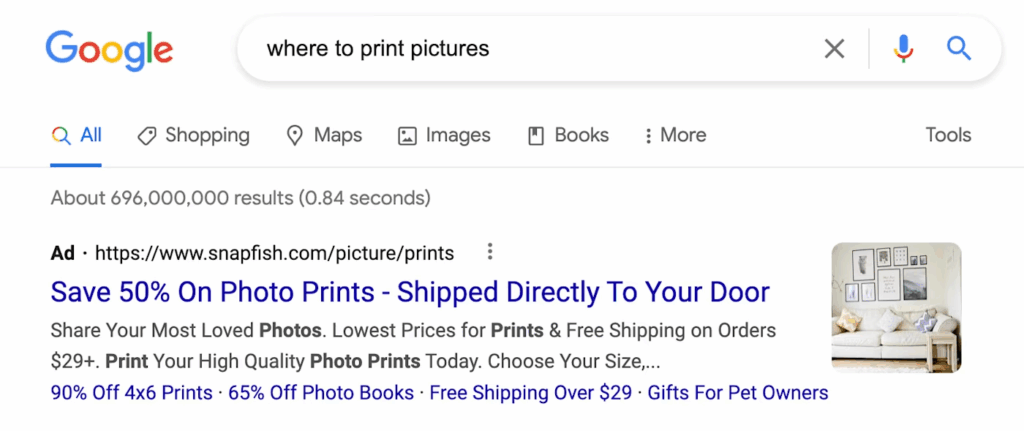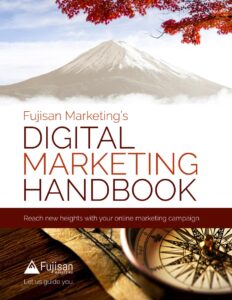Strong ad copy has been integral to campaigns for a century. Now, the critical importance of search engines in ad campaigns, the amount of content you’re competing with, and the limited attention spans you’re competing for, means effective — and efficient — copy is more important than ever.
Not only do you need to write towards the human element that’s always existed, but you also need to know how search engines themselves impact ads’ efficacy and write copy with that in mind too.
To that end…
What makes a good search ad?
To simplify, good search ad copy offers:
- Relevance
- Clear (and concise) messaging
- Compelling offers or solutions
In many ways, this feels very intuitive — but it’s always helpful to have these three points explicitly in mind, and to refer back to them when evaluating a search ad.

Image Source: https://www.wordstream.com/keyword-intent
Starting from the top, relevance to user intent means understanding what users are looking for when they search for the corresponding keywords, and making sure your ad addresses that intent. Otherwise, everything about it could be perfect, but that won’t matter to the person viewing it on the other hand as it’s irrelevant to their needs.
Further, consider that search ads, generally speaking, sit closer to the bottom of the marketing funnel (or “customer journey” funnel, however you prefer to think of it). Someone coming across your ad is actively looking for a solution to their query — is that, for example, making a specific purchase, booking a consultation for your services, or something else? Make sure your ad copy aligns with that.
Second, be sure your messaging is clear — and concise. “Clear” because, if we agree relevance is key, then it doesn’t matter if you don’t make clear that your ad is offering something relevant, and “concise” because users (reasonably) won’t take 10 seconds to read a War And Peace-length ad. Your copy is working with razor thin — arguably peripheral — attention spans to clearly convey relevance. Write accordingly.
Lastly: Provide compelling offers or solutions. Not only must your ad provide a relevant solution, it must be one that is beyond that. It must be not just relevant, but so compellingly so that it intrigues users enough to actually act on their piqued interest.
Common mistakes to avoid
On the flip side, we do often see search ads that have a few common problems. Namely:
- Poor keyword alignment
- Generic ad copy
- Weak, vague CTAs
These three are all generally antithetical to the three components we listed above that make a good search ad.
Poor keyword alignment means the keywords you’re targeting for a given search ad don’t align with the ad copy. In other words, because of the combination of target keywords versus messaging, your ad isn’t relevant to the user’s search intentions. This is obviously bad because people will just scroll past irrelevant ads — and then, compounding that, you’ll decrease your ad quality score and worsen your ad rank.
Then, generic ad copy is neither compelling nor clear (and only sometimes concise). Being descriptive and focusing on user needs makes your ad more relevant, more clear, and more compelling.
Weak or vague CTAs have a similar impact to generic copy, and in many ways could be seen as a subcategory of that mistake. Being unspecific about what action the user should take — and through implication, how your offer relates to the user’s needs — makes the final part of your ad less relevant, clear, and compelling.

Crafting strong value propositions in your ads (and why they matter)
While it sounds fancy, a value proposition is simple: the clear communication of the unique benefits offered by your product or service.
For obvious reasons, having a clear, strong, compelling value proposition in your ad is extremely important in setting you apart from competitors.
“We have a generic offer that’s not clearly distinguishable from our competitors” isn’t particularly compelling. “Here’s how we alone can offer you the best solution for which you’re searching” is.
A good value proposition not only differentiates your ad from competitors, but, quantifiably, it increases click-through rates and improves overall campaign performance.
Integrating value propositions into your ads
With all that in mind, how do you communicate these propositions within the limited space you have for a search ad?
For one, highlight your unique selling points. Even better if you can express how those align with audience pain points.
For example, a line like “Skip the backbreaking work, book movers today” empathizes with the problem or pain point someone is experiencing (the backbreaking work of moving furniture and possessions), highlights how your offer solves that (movers do it for you!), and compels the user with the action item they can take that will fix this (book said movers today).
At the same time, understand the value of different appeals — appeals purely to logic or purely to emotion aren’t universally the best practice, but each are very effective when you consider how they can align with your target audience’s values, needs, and other considerations.
Effective keyword integration
This is all about making sure your ad matches the intent of the users who are seeing it.
When you look at what your ad addresses, who are the people for whom it’s most relevant? Who will it benefit the most? And, finally, what are these people searching for that this addresses?
By ensuring this increased relevance, you’re also boosting Google’s quality score for it, which has a positive compounding effect of getting it served more often in better placements.
As part of this, some best practices for keyword use:
- Include primary keywords when possible in headlines.
- Include secondary keywords in ad descriptions.
- But avoid “keyword stuffing” by just foisting as many keywords as possible into your ad at the expense of actually communicating what you want to communicate. Further, this practice is an obvious sign you’re just trying to cut corners by cheating the algorithm.
- Understand how broad match, phrase match, and exact match categorization impacts who will see your ad and how it will be relevant to each audience.
Following best practices and just generally being critical and thoughtful about how you integrate — but don’t overly-rely on — the right keywords will:
- Enhance ad visibility
- Lower your cost-per-click
- Drive not just more traffic, but higher-quality traffic
Which leads us to the last point:
Creating value-based calls to action
When it comes to a CTA, one that is value-based both A) directly communicates clear benefits and B) encourages immediate action. A compelling CTA:
- Uses action-oriented language
- Specifies clear next steps
- Creates a sense of urgency — don’t just take action, take action now — and, to an extent, exclusivity
As an example, some — admittedly generic-ish — effective CTAs could say things like:
- “Start your free trial today”
- “Book your consultation now”
- “Claim your 20% discount”
At their most basic, value-based CTAs are ones that will work the best. They clarify expectations for users, in turn increasing user engagement and improving conversion rates.
Testing and refining ad copy
We harp on this a lot at Fujisan regardless of the topic, but a key to success with any operation is not just setting and forgetting it — on the contrary, A/B testing is super important for optimizing all elements of your work. In this case, ad copy.
A/B testing will help you determine your best-performing elements, and from there you can adjust your copy, test, adjust, and so on to continuously improve your ad’s effectiveness. As part of this process, you can (and should) test headlines, descriptions, CTAs, ad extensions, and other factors while controlling for other variables.
From there you can analyze resulting variables implicit in your ad’s and greater campaign’s success, like click-through rates, conversion rates, and quality scores, and implement changes accordingly.
In general, copy is one of the most important closing factors in an ad’s performance. While some find it tempting to overlook its effect and try to put in the minimum effort or outsource it to AI who can create a generic facsimile, the reality is that you can do everything “right” with ads, but with bad copy it will all be for nothing.
By focusing on the details, keeping note of the resulting metrics, and testing performance, you’ll be setting your campaigns up for success with a leg up on your competitors.




